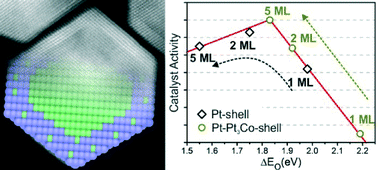Atomistic understanding of the origin of high oxygen reduction electrocatalytic activity of cuboctahedral Pt3Co–Pt core–shell nanoparticles†
Abstract
PtM-based core–shell nanoparticles are a new class of active and stable nanocatalysts for promoting oxygen reduction reaction (ORR); however, the understanding of their high electrocatalytic performance for ORR at the atomistic level is still a great challenge. Herein, we report the synthesis of highly ordered and homogeneous truncated cuboctahedral Pt3Co–Pt core–shell nanoparticles (cs-Pt3Co). By combining atomic resolution electron microscopy, X-ray photoelectron spectroscopy, extensive first-principles calculations, and many other characterization techniques, we conclude that the cs-Pt3Co nanoparticles are composed of a complete or nearly complete Pt monolayer skin, followed by a secondary shell containing 5–6 layers with ~78 at% of Pt, in a Pt3Co configuration, and finally a Co-rich core with 64 at% of Pt. Only this particular structure is consistent with the very high electrocatalytic activity of cs-Pt3Co nanoparticles for ORR, which is about 6 times higher than commercial 30%-Pt/Vulcan and 5 times more active than non-faceted (spherical) alloy Pt3Co nanoparticles. Our study gives an important insight into the atomistic design and understanding of advanced bimetallic nanoparticles for ORR catalysis and other important industrial catalytic applications.


 Please wait while we load your content...
Please wait while we load your content...